Genuine Historical Images
Revised 5/31/25 Removed one photo
The modern practice of males participating in aquatics in the nude had a long tradition already in place as the 20th century dawned. This posting presents some the unquestionably authentic images documenting this practice up through mid-century. They serve as graphic illustrations of the history of this practice.
These images are authenticated in various ways. Some are deemed real because they have plausible names and dates attached to them, some because they originate from reliable sources and some because they resemble verified images. In all cases, evidence of fakery is absent.
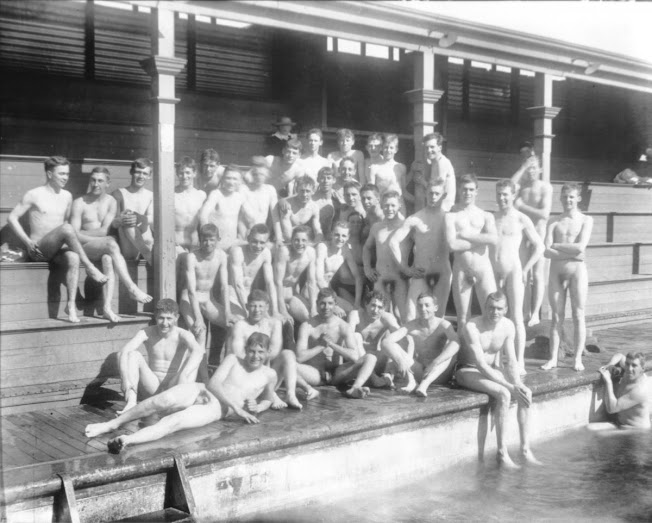
These sturdy fellows are denizens of what were called floating bathhouses. These were prevalent in the late 1800’s and early 1900’s. In fact, this designation was a misnomer. The bathhouses pictured did not “float”. They consisted of picture frame piers that extended into natural bodies of water – typically flowing rivers. The enclosing walls lent privacy. In the center was the “well” where the swimming and diving took place. These facilities freely exchanged water with the host river, continuously changing the aquatic medium. Submerged horizontal slats prevented ingress of large floating debris that might cause injury or simply inconvenience.
Of course the slats were no barrier to typical pollution such as oil slicks, sanitary runoff or industrial discharges. Doubtless there were days when the swims were called off until the water cleared. Even on acceptable days, I imagine that stinging eyes, rashes and lesions were regular occurances.
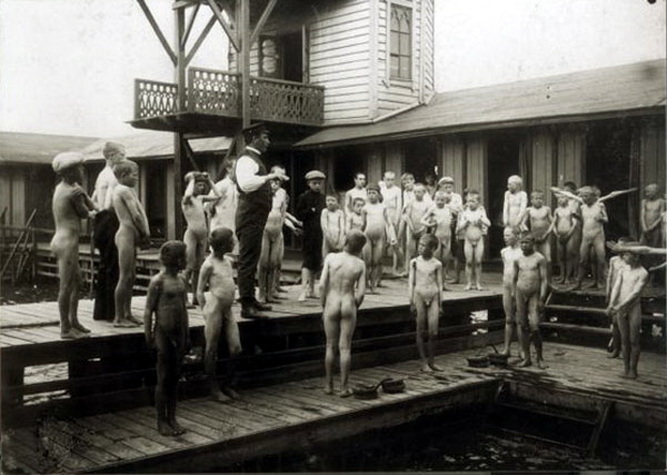
This fourth image shows that these types of facilities were for family use as well. Note that this bathhouse had two wells. It also has curtained changing rooms along the back and what looks like a diving platform. The youngsters are likely here for swimming instruction being dispensed by the suited gentleman (who apparently has no intention of joining his young charges in the water). As with the adults in the previous images, they require no more equipment than that which they were born with.
New York city adopted similar types of much larger facilities for public recreation as well as hygiene. They were intended to allow the occupants of the squalid immigrant tenaments the opportunity to wash as well as to escape the summer heat. They were in use from the 1890’s until the 1920’s when pollution in the Hudson and East Rivers became intolerable (Resource C).
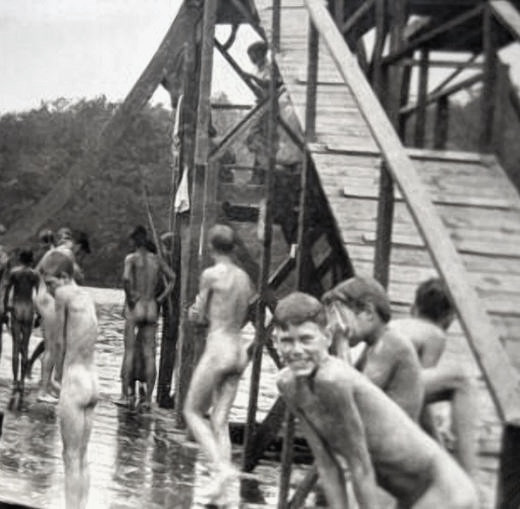
This is another dock-based swimming facility on a natural body of water with a diving tower. In this case, it has all male patronage without a stitch of clothing anywhere. This might be a boys’ summer camp. The take away is that towns and private organizations provided facilities for swimming and diving, usually segregating the sexes.
Note that I have and there are many more of these dock and floating bathhouse swimming facility pictures, but to post them here would be redundant. We’ll catch them up in later posts.
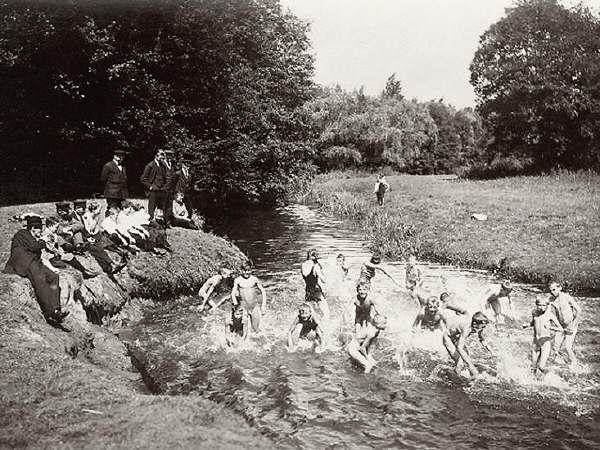
All of the types of public facilities depicted in the foregoing images are descended from a common ancestor, the “ol’ swimmin’ hole” as shown here. This undated image shows two (slightly older?) suited girls cavorting among a group of naked young boys while various over-dressed adults look on (enviously?) in apparent approval.
With all of the advantages of natural swimming facilities, a densely populated, industrialized society quickly bumped up against limitations. During the late 1800’s and first half of the 20th century, various diseases whose transmission was facilitated by tainted water became endemic. Typhoid and polio were two such pathogens. Polio particularly reached epidemic proportions before vaccines were developed in the 1950’s. Infections seemed more prevalent during the summer months when aquatically inclined children were more likely to encounter creek, pond and lake water contaminated with fecal matter.
Recreational swimming now moved to man-made facilities and the first pools were born.
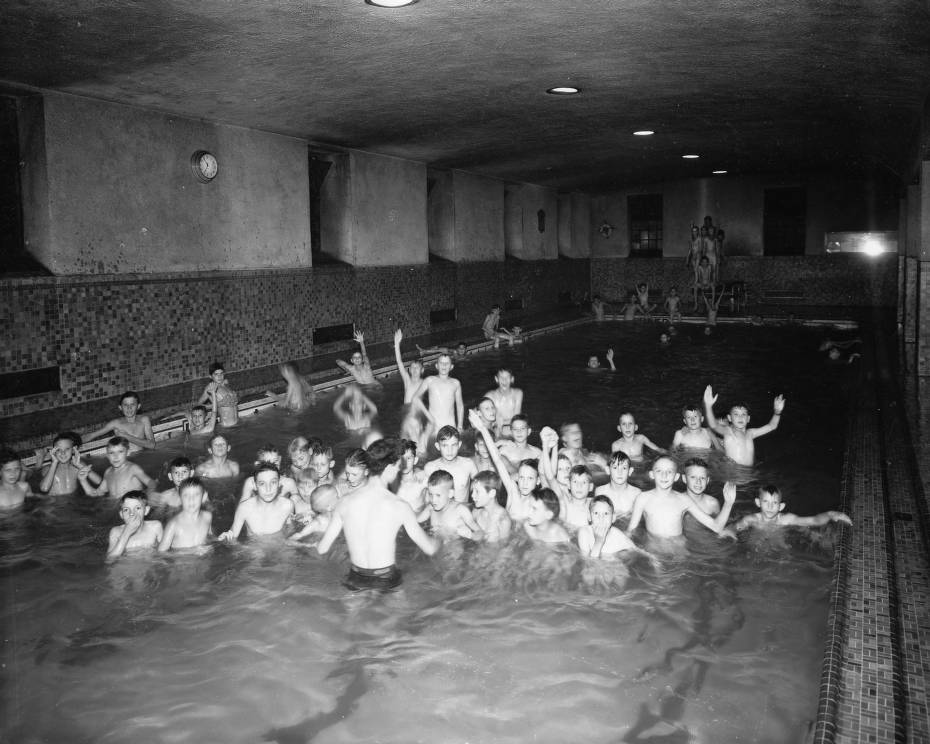
The designation as the first “pool” is a game for any number of players. Particularly since “bathing” pools in “bathhouses” were the earliest incarnation of these facilities. The idea of a pool exclusively for recreational swimming came along later. In general terms, the first swimming pools in the US appeared in the 1880’s. The first YMCA pool was attributed to the Brooklyn “Y” in 1885. Pools in the UK have a lineage dating back to the 1830’s.
Concrete pools were called “tanks” in the early days. That is probably because they were little more than water holding vessels. They basically had an inlet pipe for filling and a drain for emptying. There was no continuous circulation of water for filtration and chemical treatment. Needless to say, any volume of stagnant water left to its own devices will eventually become foul, swum in or not. In effect, the public health hazards of swimming had simply moved indoors.
The problem was addressed by a number of measures. The most conscientious of pool operators would drain the pools, scrub down the walls and bottom and refill it with clean water weekly. Of course, this was time consuming and labor intensive. Less committed pool owners might try shortcuts such as a partial draining and refilling, skimming, addition of treatment chemicals and so on.
Continuous or periodic circulation of pool water through an external filtration system was introduced in the early 1900’s. Chlorine sanitization was first used around 1910. Still, the equipment available was not up to the task of completely preventing contamination and the spread of infections. More active administrative measures were required.
Of course, limiting the amounts of contaminants introduced by pool users was an obvious strategy. This picture of an early pool illustrates part of the strategy – have ‘em swim naked.
The image above captures the state of the practice in the mid-1930’s. All but the instructor are bare.
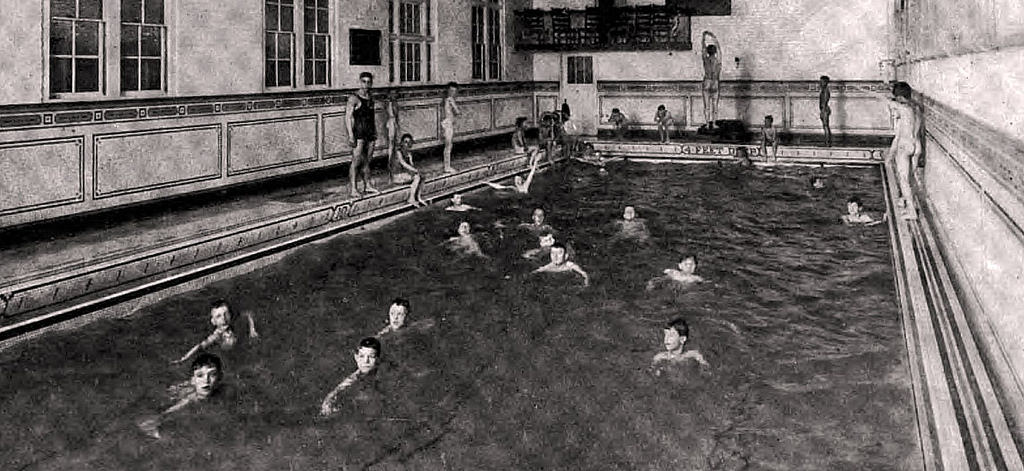
Accordingly, the American Public Health Association in 1926 promulgated the recommendation that all boys (but not girls!) swim nude. This stood until 1962 when it was recognized that pool sanitation technology had reached a level where forbidding bathing suits was superfluous. While it was in force, mandatory nudity was buttressed by a requirement to take a warm soap shower and submit to a health and hygiene inspection before entering the pool. Rationale: No bad stuff in, no bad stuff can accumulate.
The image above seems to have been retouched to sharpen the details to make them visible at a distance. My assumption is that this was done when the picture first released as part of the publication process. That this was published is suggested by the screening effect visible across the image. This is discussed in a later posting regarding fakes.
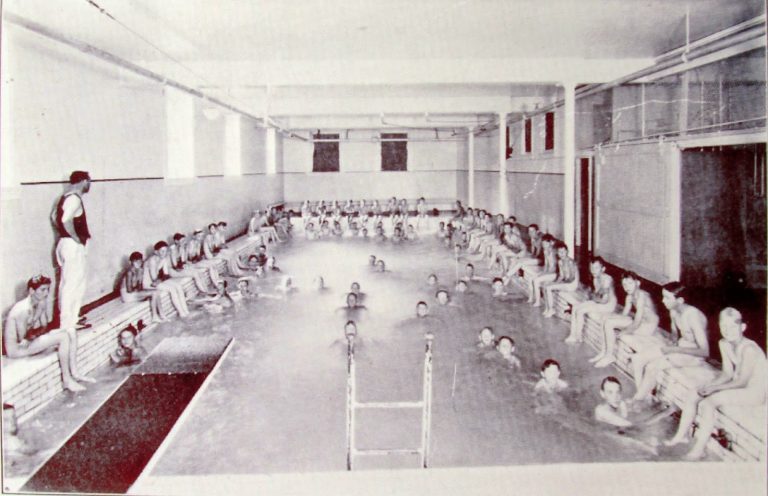
The instructor in this image certainly has his hands full with a large class of wannabe swimmers of a variety of ages. It is undated (I suspect pre-1930) but the location is called out. It may or may not be noteworthy that a diving board shows in this picture. The earliest pools tended to be wading affairs with depths usually under 5 ft. That would not be considered sufficient depth under a diving board.
Looking back at image 6, all of the figures in that pool seem to be standing on the bottom for the full visible length of the pool. In image 7, those in the water farthest from the diving board seem to be standing on the bottom, but those in the “deep end” are clinging to a side rail. That suggests that this is a second or third generation pool suitable for diving.
Parenthetically, the lone instructor may not be that lonely. The swimmer in the lower right corner looks like he may be an adult. The neat part in his hair may suggest that he slipped into the water for the picture since he was sans any clothing. Note in this and other posed photos, the family jewels are tucked neatly away.
I have a few more images of early pool swim classes, but I didn’t see the need to belabor the point by including them right now. I’ll offer them later.
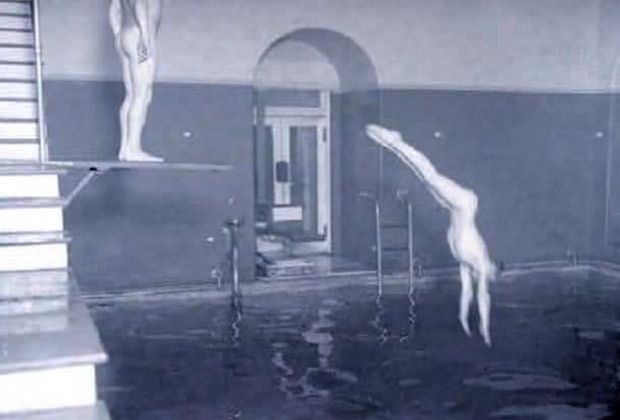
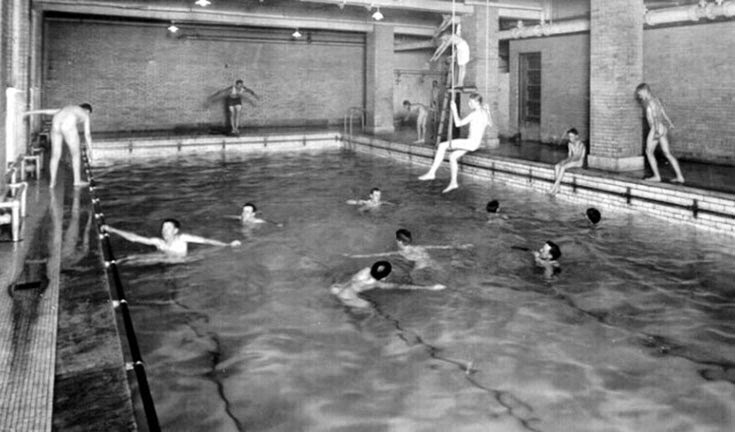
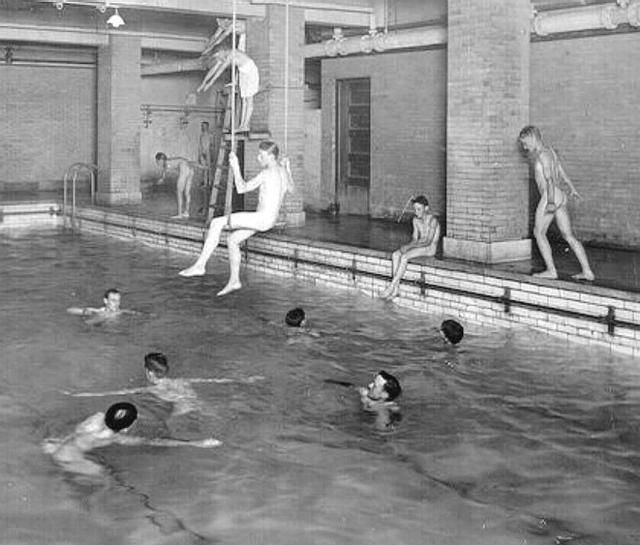
These three images are undated but I’m guessing that they are probably around the same age as the previous images (1920’s and 30’s). Although staged, these are action shots that illustrate the functioning of the facility.
The attention-getting items here are the improvised diving stands. The diving board in the image 8 looks like little more than an ironing board attached to a stairway and certainly is not a spring board. In Image 9, the two platforms seem rigged to a (free standing?) ladder. Both arrangements would not conform to present day safety practices. Then there’s the matter of the water depth …
The trapeze is apparently a once popular pool accessory has become extinct – thankfully.
As with the previous two images, all penises are tucked out of sight. In fact, one wonders if the sexual appliance on the diver in image 8 was removed by retouching. The absurdity of the two divers posing in towels in image 9 goes without saying.
The next batch of material in this posting requires a bit of a prologue.
In 1883 a weekly magazine named LIFE began publication. It was a topical rag containing light entertainment and humor as well as illustrations and cartoons. In 1936 the descendants of the original publishers sold out to Time, Inc, producer of the well-known weekly news magazine. Time made LIFE over into an all-photographic journal. It proved extremely popular and continued in weekly publication until 1972.
It was during those years that LIFE featured all sorts of photo essays on almost any topic. School life from kindergarten through college was a recurrent theme. Phys ed (including communal showers) and swimming did not escape scrutiny – even if nude males were in the lens.
This digression into a defunct magazine is pertinent to the current topic because the images of nude male swimming it presented provided indisputable proof that the practice existed and was widespread for decades. Pictures from LIFE’s pages and from its unpublished archives were named and dated. By the way, they were uniformly high quality.
One point about the LIFE archive is that it reportedly contains on the order of 10 million images. One comment suggested that 97% never made it into the magazine but are available somehow (I had limited success accessing them, but others apparently have had more luck.). Based on my observations, photos that were published are clean but the unpublished ones have the LIFE watermark in the lower right. Because they are floating freely on the internet, they are unattributed. The next few images are in that category.
Many of the following images are from that source.
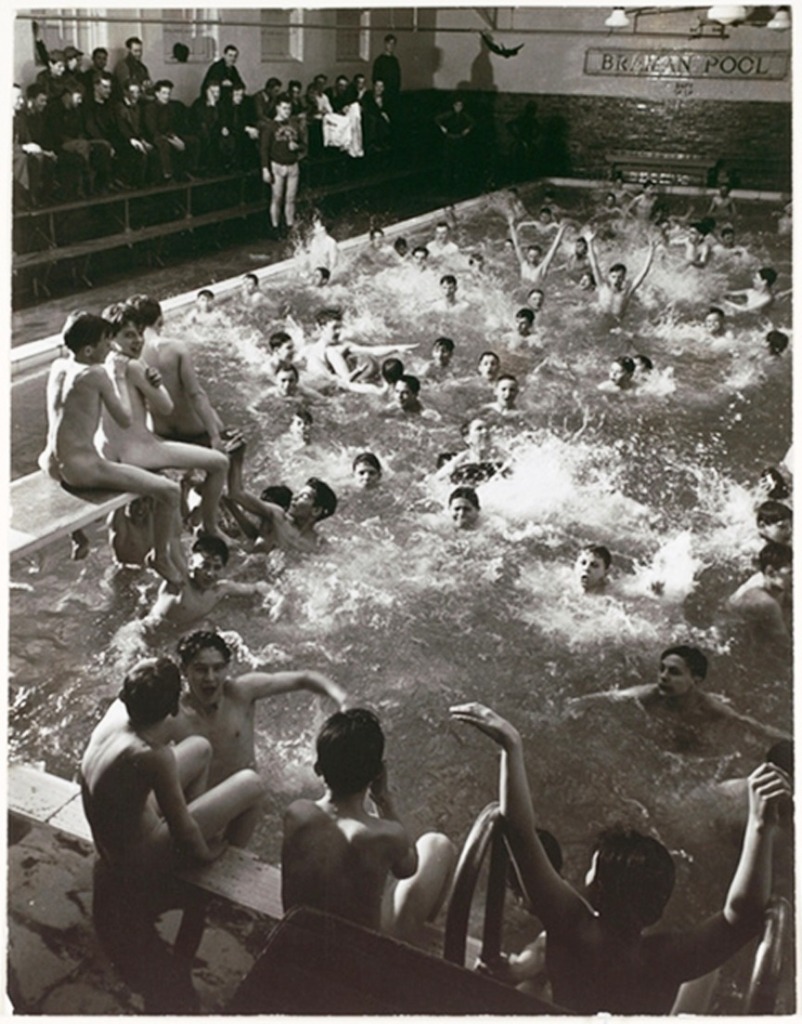
There was no difficulty verifying this very well documented image. It was embedded in an article (with several other pictures) about a club pool in a hard-scrabble pre-war mill neighborhood. This club produced multiple national champions, promising a way out of a working-class existence for some talented sportsmen via scholarships. The older guys populating the bleachers wearing matching warm-ups are no doubt the varsity club members waiting for the kids to clear out and cameras to be stowed before they change into their birthday suits for serious exercise.
One point about the LIFE archive is that it reportedly contains on the order of 10 million images. One comment suggested that 97% never made it into the magazine but are available somehow (I haven’t been able to access them, but others apparently have.). Based on my observations, photos that were published are clean but the unpublished ones have the LIFE watermark in the lower right. Because they are floating freely on the internet, they are unattributed. The next few images are in that category.
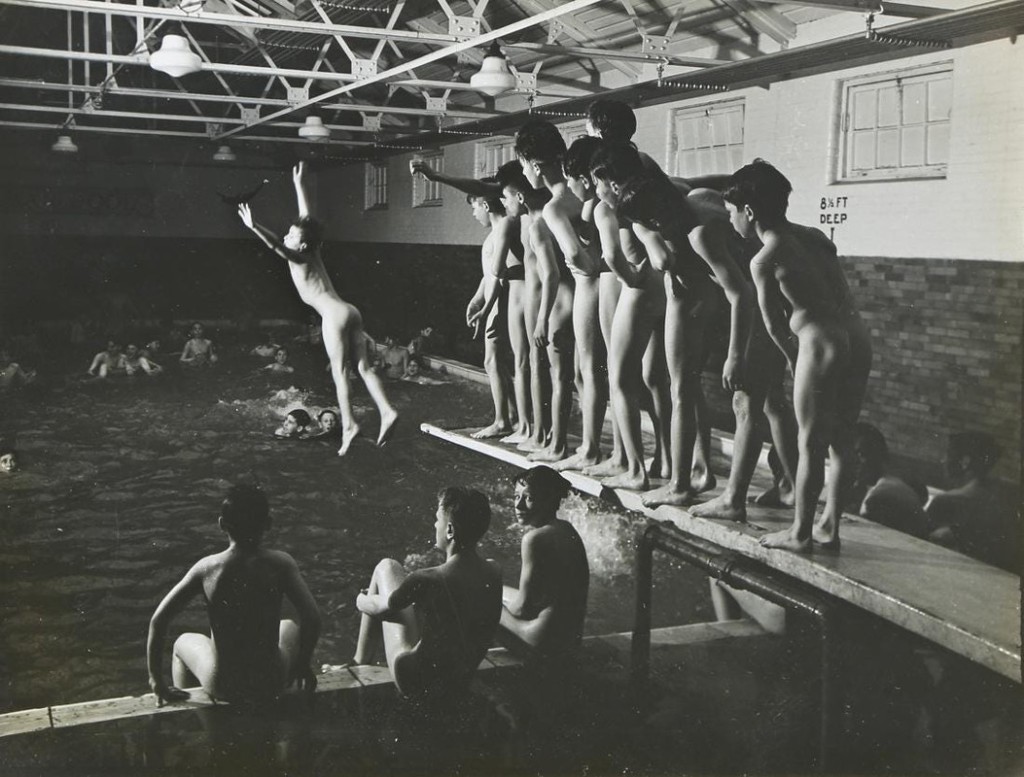
This image is from the Olneyville neighborhood Boys’ Club of Providence, RI – the same venue as image 13 (above) and it appeared in the same LIFE article. The exuberance of the participants is not in doubt. Since these pictures appeared in a national magazine, the naked boys were seen by family, friends, classmates, etc. No big deal back then.
As an aside, this facility is long gone, closed in the 1980’s.
Another LIFE article that appeared in the March 7, 1938 issue profiled the swimming program at the University of Michigan. The swimming and water polo teams were helmed by a flamboyant British expat named Matt Mann. I was able to access the archive of all of the photos that were taken during LIFE’s visit, few of which made it into the magazine.
Here are some of the most relevant images – none of which appeared in the article.
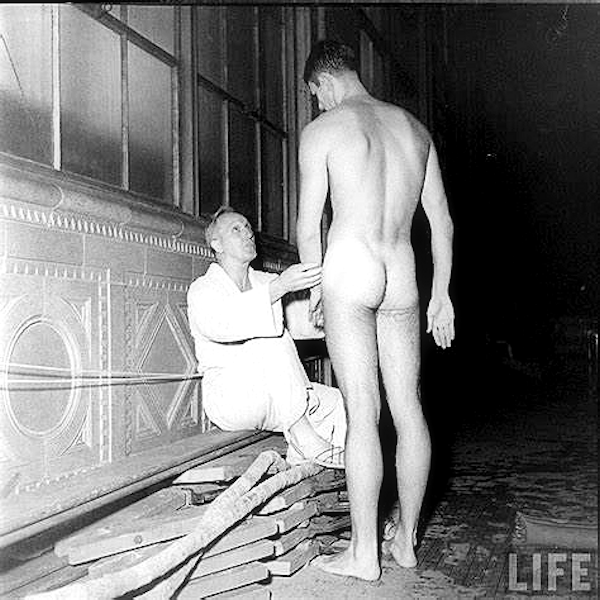
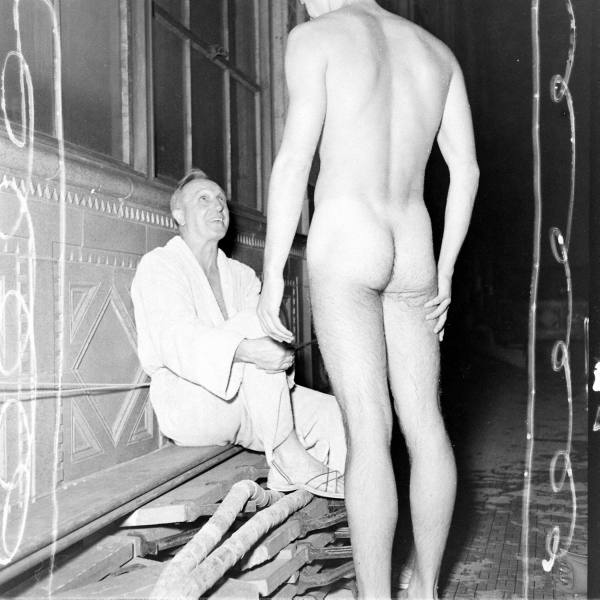
He’s the one in the robe. I was able to identify him from the pictures in the LIFE article. I assume the naked guy is a team member. I admit this looks a little weird, but I’m sure it was an entirely appropriate interaction. <wink>
By the way, college-coach-in-a-robe seems to have been a practice during some period. There are one or two such images in subsequent posts. I speculate that the team coach attended practices nude but wore a robe if his presence was not immediately required in the pool.
One other point is that this image does not bear the LIFE watermark, but it does show some cropping marks. This may have been considered acceptable for publication at one point. As it happens, no nudes appeared in the article.
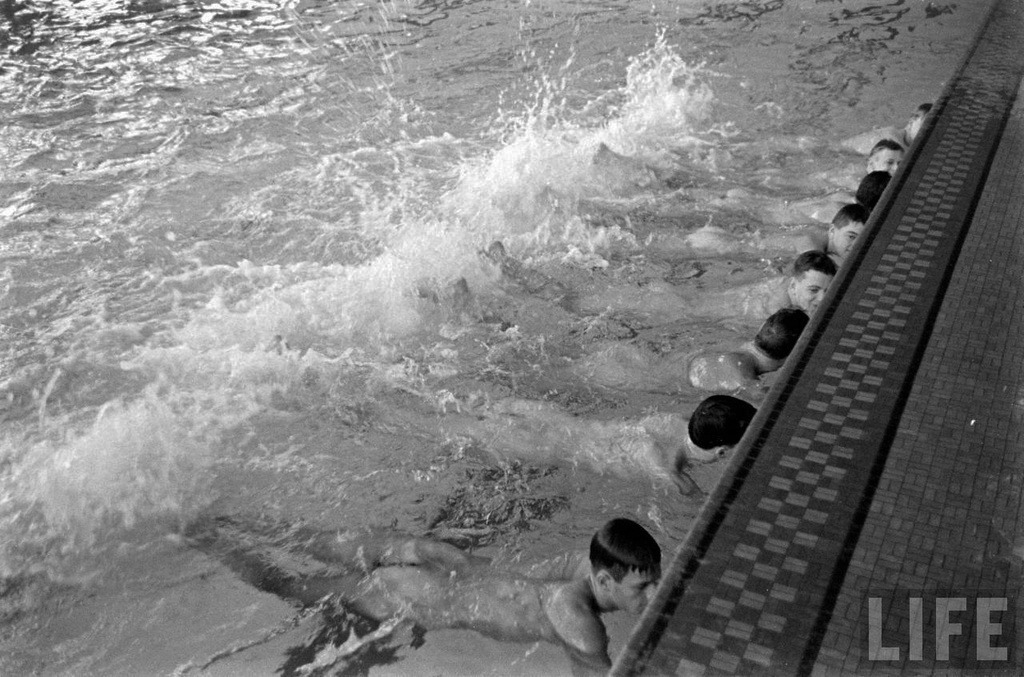
This mass kicking exercise was also staged for the LIFE article but then left out. It is interesting how these deleted pictures tell a very different story from the published photos.
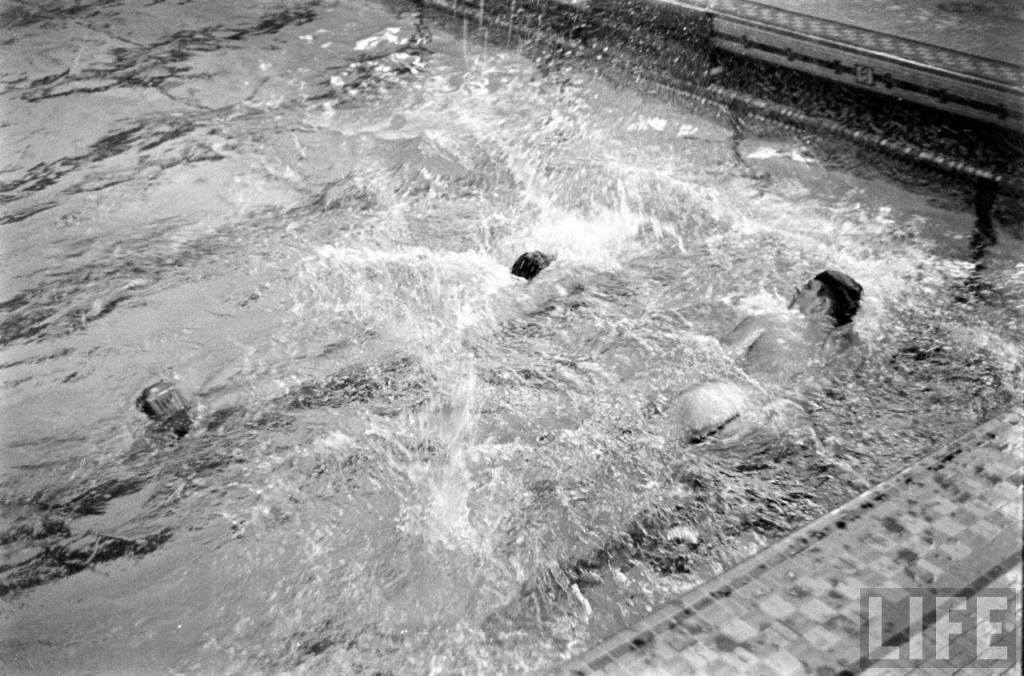
As we continue looking at the same University of Michigan images, this looks like some competition is under way. However, these guys don’t look like the finely condition swim team members. This may be a Flounders moment. (See the Flounders section on the Not So Special Topics page.)
There is no doubt about the nudity of the participants as the guy on the right has rolled to display a fine moon.
Coach Mann was a champion for swimming education for all of the UM community – faculty, students and their families. Some of these images may well be from those instructional sessions.
Now let’s look at the collegiate swimming scene.
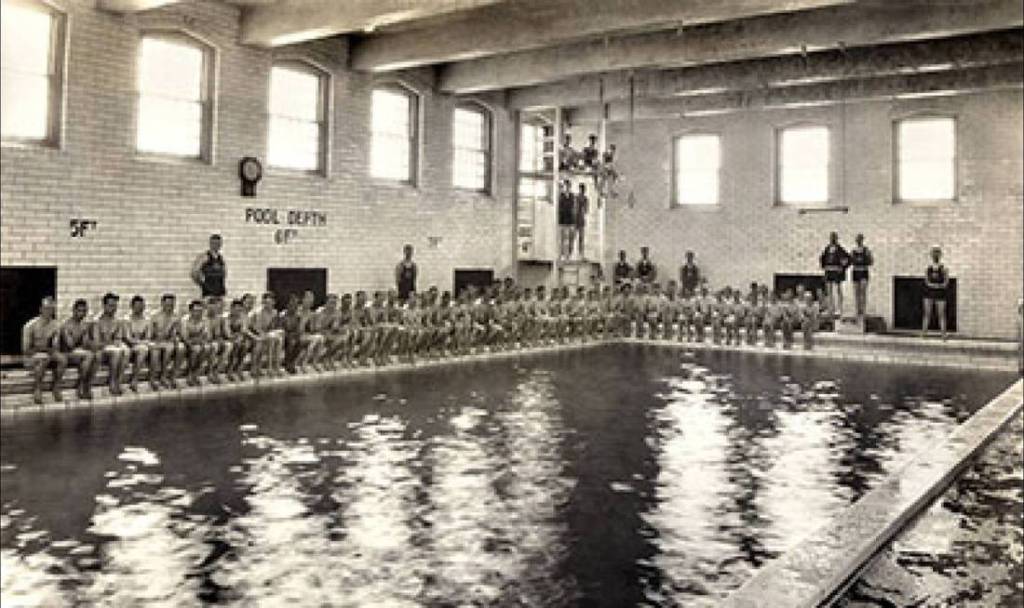
This image memorializes the universal practice in state colleges and universities across the country in this period: The Freshman swimming test. According to accounts, all male freshmen students were required to take a proficiency test upon the start of their college career. If they passed, it was the last time they would be required to be in the pool for the rest of their college attendance. If they failed the test, they were required to take a semester course in swimming instruction. If they failed that course, they would be required to repeat it until they successfully completed it.
Note that the testees – about 60 of them – are arrayed in their birthday suits while the instructors and assistants are dressed in authentic tank suits of the era. I’ll go out on a limb here and guess that in a landlocked, rural state like Iowa, there was a high failure rate.
The mass kicking exercises were much beloved of photographers apparently. Here are some not attributed to LIFE.
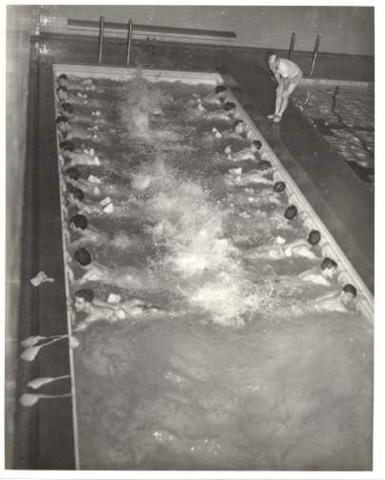
These guys must be rank beginners, since they’re using floats to keep them buoyant.
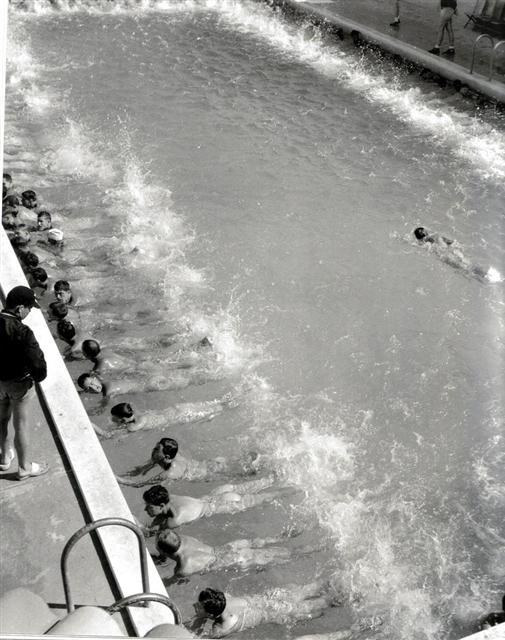
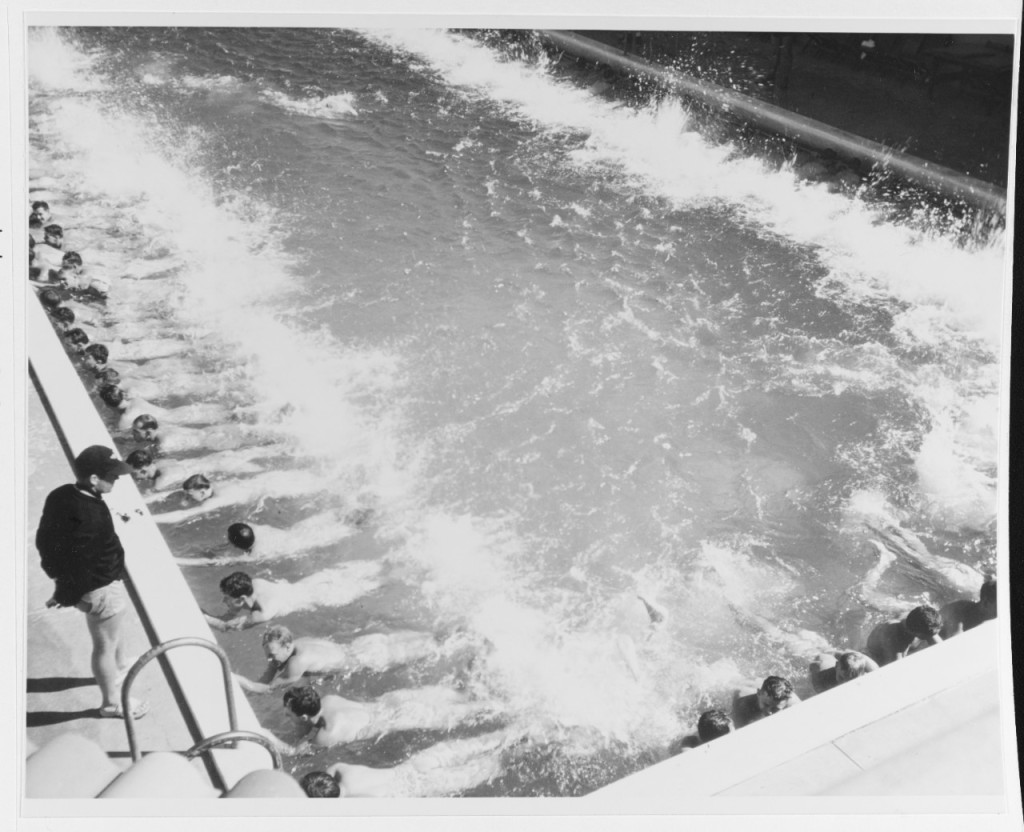
This is a pair of images of the same scene taken minutes apart (note the lone swimmer in the center has turned and is headed back in the second photo). It is of a Navy pre-flight instruction school in California in 1943. These photos come to us courtesy of the National Archives. I guess the Navy couldn’t source that many swim suits quickly and these guys’ training had to be moved along since there was a war going on.
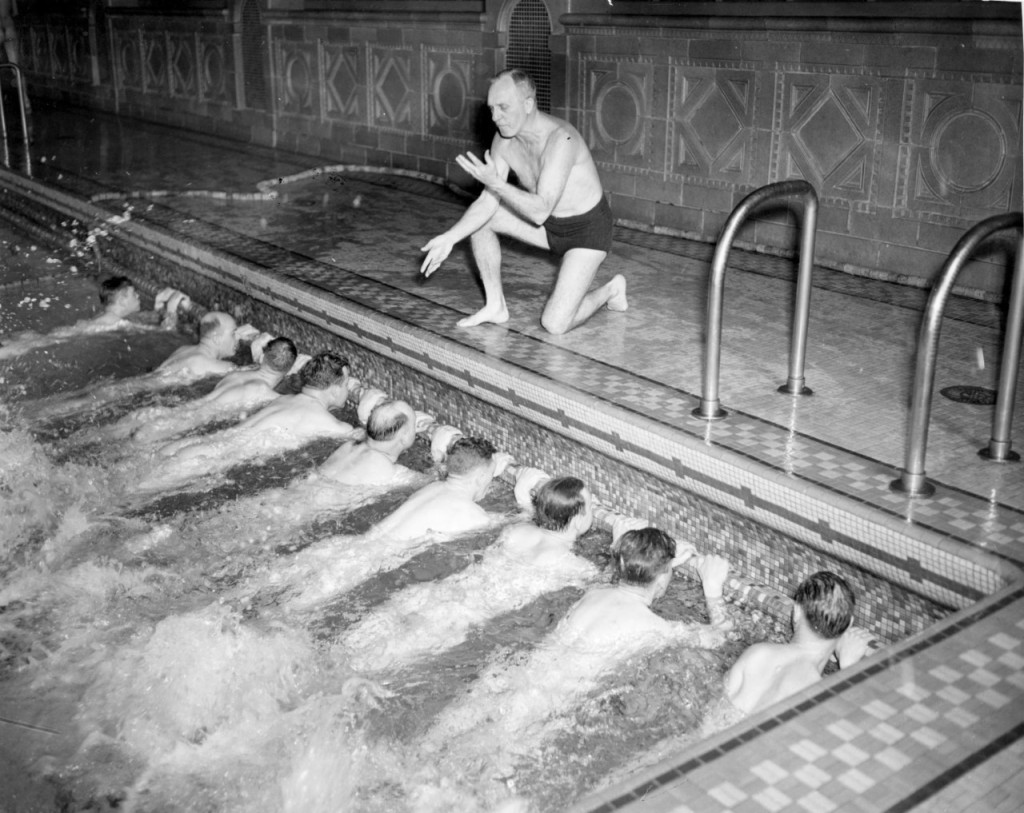
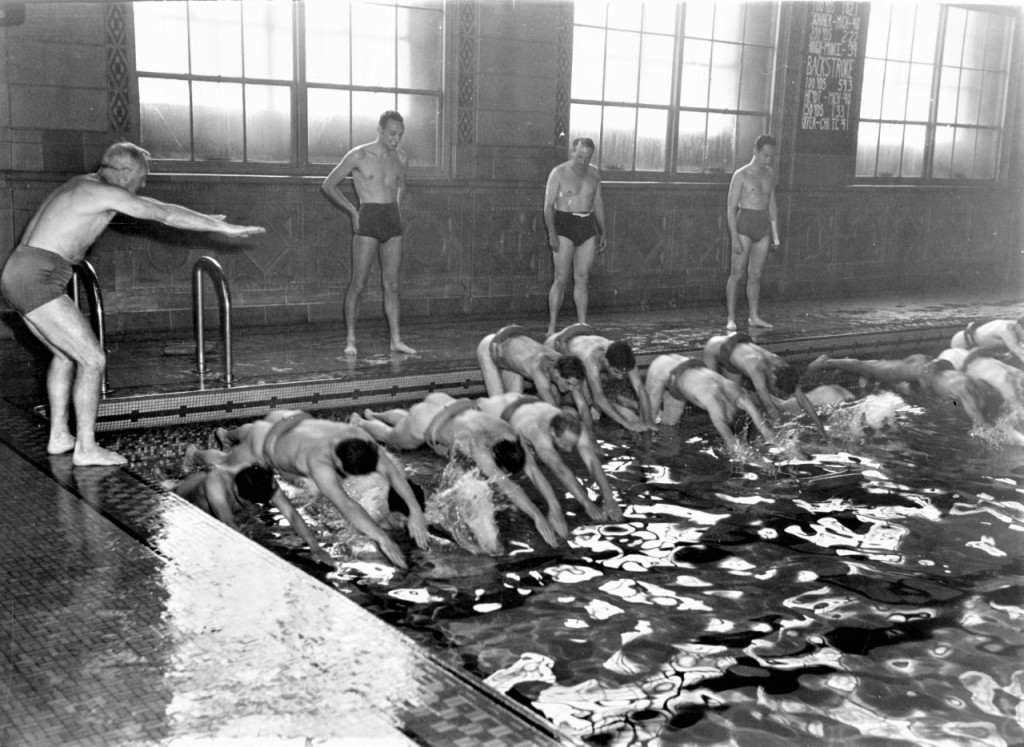
UM did its bit for the war as well. We’re back in Ann Arbor under the direction of Swimming Hall of Famer Coach Mann. These images were acquired from the Bentley Historical Library of the University of Michigan Libraries. According the archival notes, they date from 1944 and depict military flier training.
A close inspection of the first image discloses the presence two bald-headed gentlemen among the class. While premature male balding is not unknown, I would expect such a class to include only 19-to-25-year-olds. These guys appear older.
The participants in the second image seem more typical and the presence of close supervision seems to bear out the military purpose of the exercise. The flotation rings around their middles are apparently conditioning devices. They create drag, forcing the swimmers to work harder. I have seen other training photos where Coach Mann had guys swimming with their ankles bound together with these rings. However unorthodox his methods, his success in competition was beyond question. But one convention he did follow was having his trainees perform their activities in skins only.
Not to be outdone, we give you the legendary swimming coach Bob Kuphuth of Yale University when LIFE visited in 1937. Our man is giving his “boys” a little air before he starts a hard day of coaching.
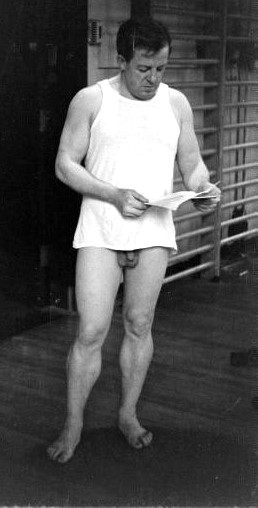
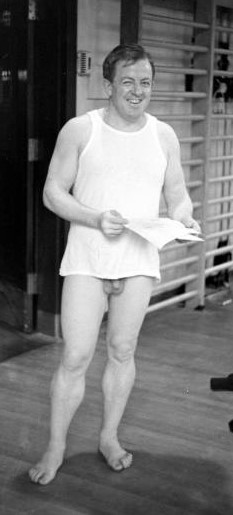
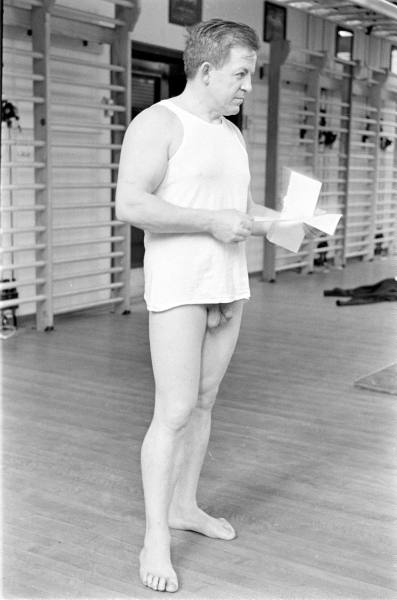
We now return you to your neighborhood Y and local high school.
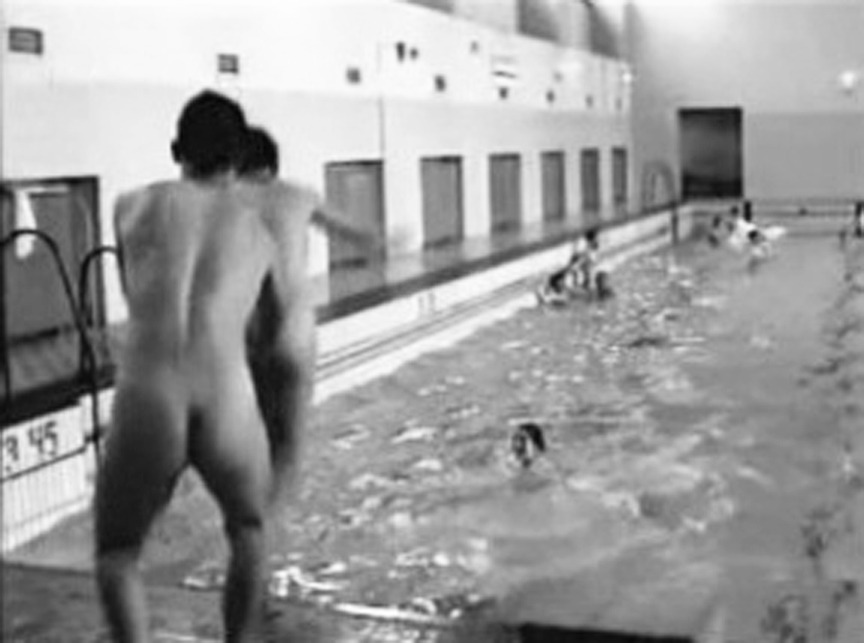
No attribution here, but it could easily be a scene from any afternoon at the Y.
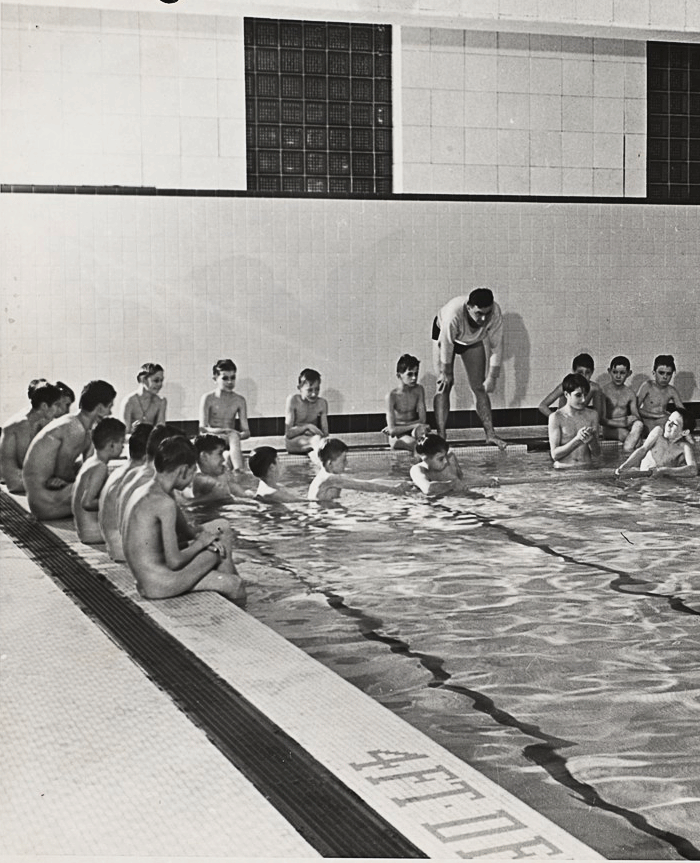
This looks like a swimming lesson, but the kids in the water look like they’re having a tug o’ war. At least they’re not encumbered by bathing suits.
This otherwise unattributed image is from the archives of the Boys’ and Girls’ Clubs of Greater Boston held by the Northeastern University library. The Archive contains pictures from a period between 1924 and 1993. I’m guessing that this photo probably dates from the late 1950s or early 1960s.
It is noteworthy that the nudity rule notwithstanding, adult males conducting swimming lessons were often required to wear suits. This contradiction slides right in with the stipulation that girls must wear suits.
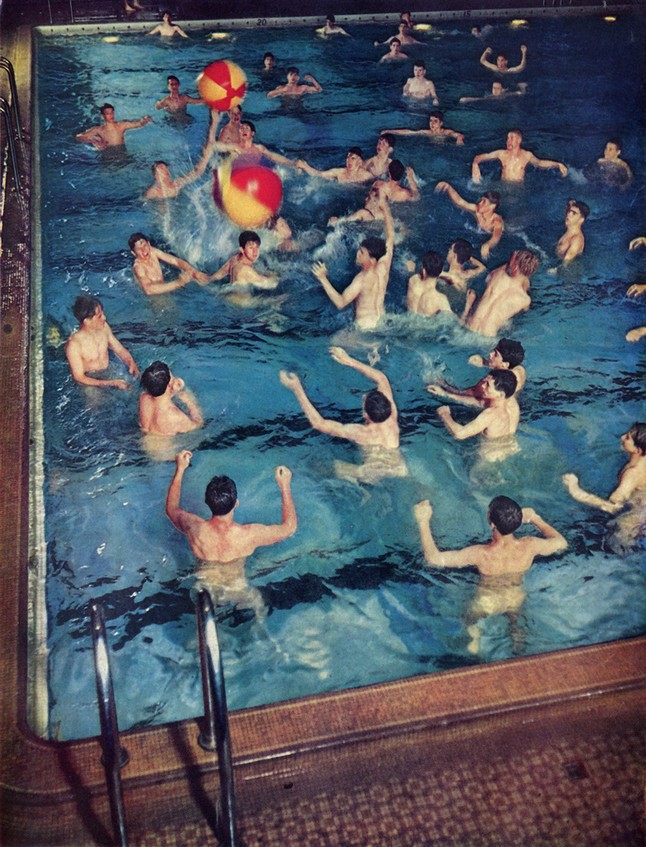
In a special report about America’s schools, LIFE featured this school in a wealthy suburb of Chicago. The pool apparently cost $400,000 when it was built in 1932. Go figure. Anyway, the students in this picture are warming up for a PE class game of water volleyball – unencumbered by any nasty old swim trunks. Note that they could well afford swim suits – poverty being one of the arguments for mandating nude swimming in schools – but apparently have no problem going without.
By the way, there was no mention in the text of the article that the swimmers were nude. That was apparently unremarkable.
It so happens that there is another photo of this event that did not appear in the magazine. Here it is.
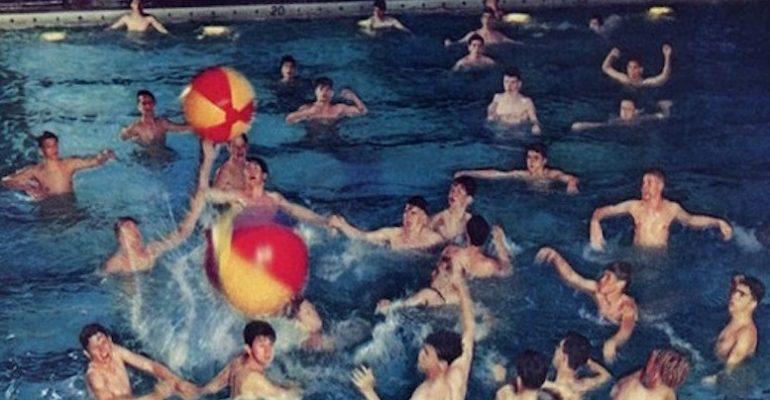
This is not as high a quality image as the previous photo. Too, it does not reveal the nudity of the participants.
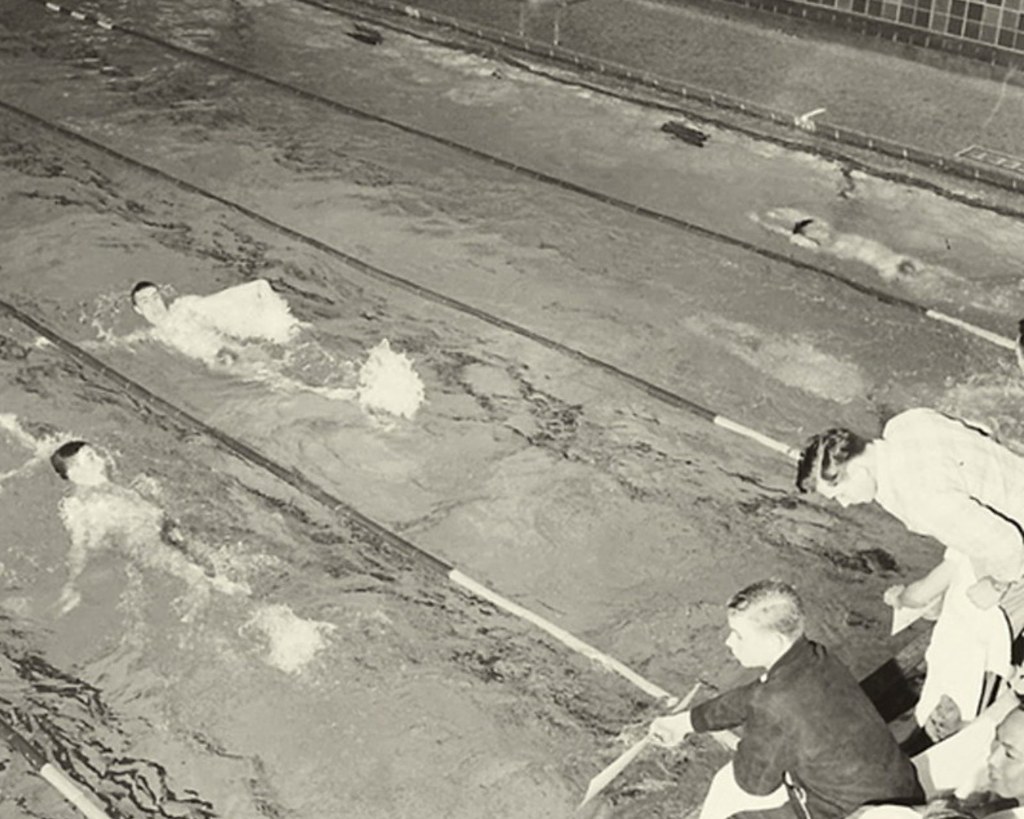
Nothing says “look at me” like doing the backstroke in the nude. These guys are obviously well through puberty and displaying their manhood proudly.
Based on the foregoing collection of images, one could draw the conclusion that swimming was exclusively a white person’s activity. Indeed, there was a widely-held stereo type of black people that said that they eschewed water sports in any form, including the frozen water typical of winter sports. In fact, the dearth of Afro-American participation was most likely a due to a lack of access rather than interest.
One of the limited number of swimming venues available to black kids was the Centre Avenue YMCA in Pittsburgh. Built in 1922, it was long the only Y open to blacks in western Pennsylvania. This situation was not unusual, since de facto segregation was practiced in nearly all of the US in our period of interest.
As it happened, Pittsburgh was also home to a prolific Afro-American photographer, Charles “Teenie” Harris. The following three images were made by him at the Centre Avenue Y.
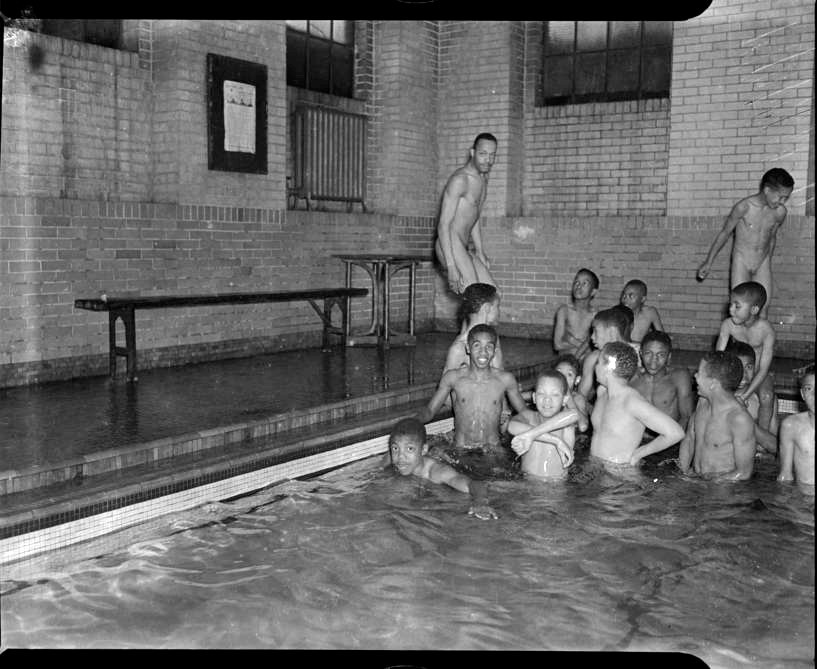
The subjects of this photograph seem caught by unawares, especially the one adult. He is remarkable in that, although it is widely known that nude men (especially fathers) swam with boys in YMCAs, it rarely shows up in the photographic record. Usually, if boys are in the pool the adults present are dressed and standing on the deck overseeing the proceedings. This image dates from sometime between 1938 and 46.
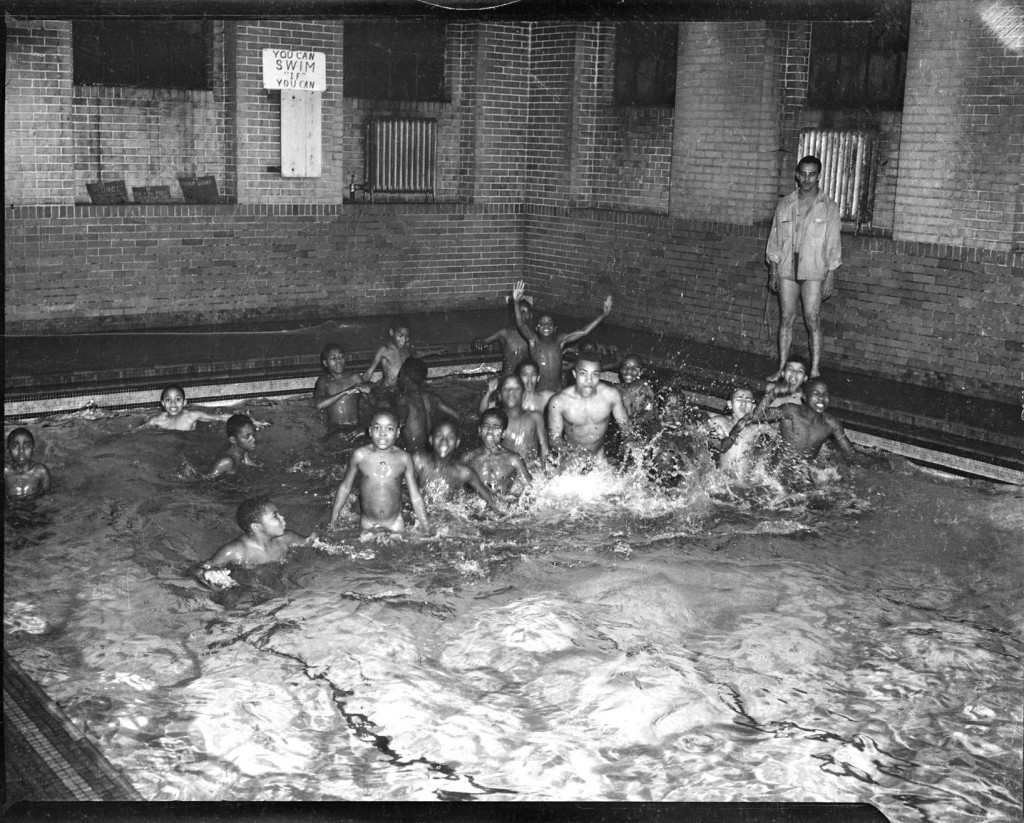
Here is another photo (dated 1951) in the same pool with the perspective rotated 90 degrees from the previous picture. Note that there are now two adults in the frame, one in the traditional position (suited and on the deck) and the other in with the boys. A close inspection confirms that the latter is indeed nude (bare hip). The boys are exuberantly reacting to the camera and their big companion seems okay with it. One cannot overlook the torso development of the man in the water. One wonders whether he was some person of note (an athlete?) in the local community.

Kudos to our intrepid photographer for freezing the diver in flight for this arresting image. Although the diver is suited, there appears to be a difference of practice among the members of his audience. Although the quality of the photo isn’t the best, some seem to be wearing suits or shorts while others are obviously going without. Once again the focus is on the one adult who seems to be receiving the highly deferential attention of the boys. The date of this picture is reported as “1940-50.”
These images are contained in the Harris archives maintained by Carnegie Mellon University.
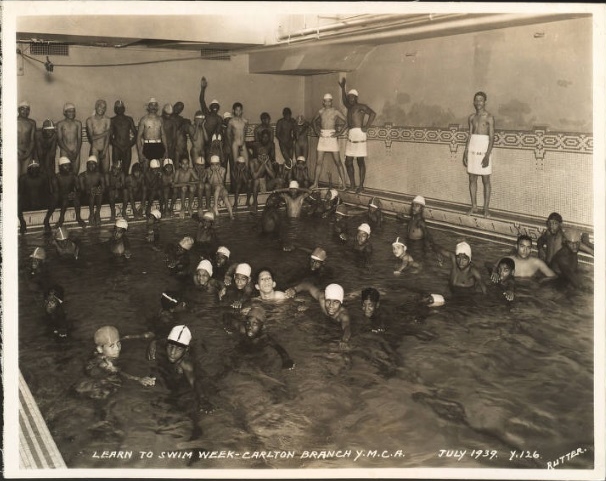
This image shows that African American aquatic opportunities did exist elsewhere. This photo is from a Brooklyn YMCA in 1939. The Y deserves credit for making this sort of recreation available in all kinds of neighborhoods without regard to race. Parenthetically, the near universal use of bathing caps is a curiosity.
Authentication comes from the fact that this image was lifted from the official US YMCA photo archive (Kautz Family YMCA Archives) that now resides in University of Minnesota library. Most of this material (which includes over 75,000 photos) is undigitized, so it is not available on the internet. A few items like this one made it out.
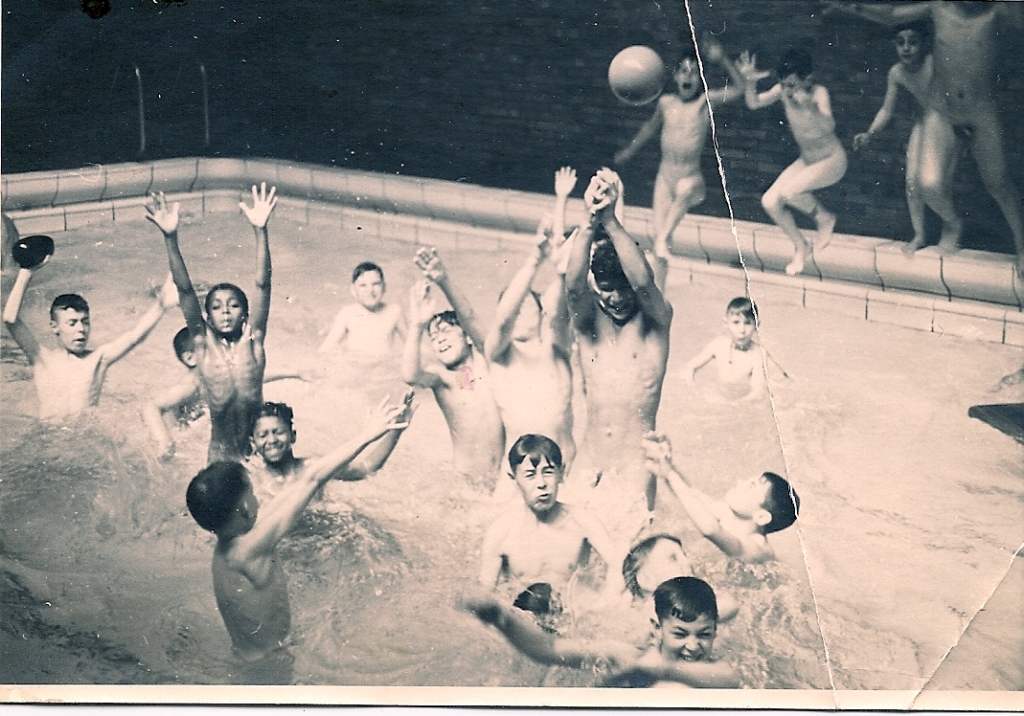
This undated image is from a set of three from the archives of the Fox Point Boys’ Club of Providence, RI. This was a sister club to the Olneyville club depicted in the 1940 LIFE photos above. All of the pictures in this set show a mixed race group of boys frolicking in the pool. Although not in the best condition, I chose to post this one because it shows that the boys are obviously nude – none of that waist-deep water copout.
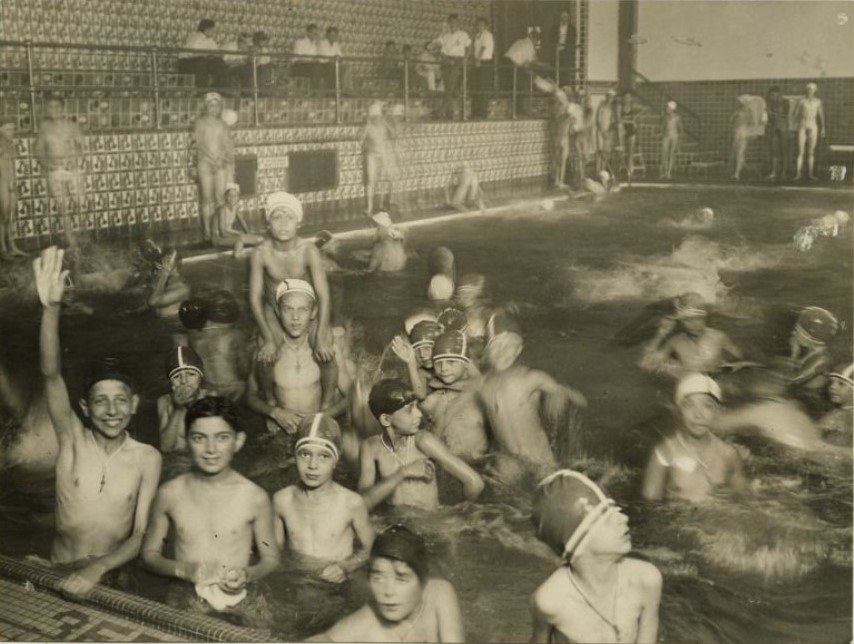
As long we’re poking around ethnicities, we should look at this one from the American Jewish Historical Society. Its attribution is simply “boys in an indoor pool c. 1920.” This is a curious image due to its near-universal use of bathing caps in conjunction with complete non-use of bathing suits. The pool operator must have been particularly keen to keep hair out of the filtration system.
Some of the guys on the deck had the presence of mind to cup their hands in front of their genitals, but they needn’t have bothered. As you can see, there are scant details discernible due to the slow speed of the film used. I will, however, hazard a guess that all of these boys were circumcised.
This concludes our round up of the most “real” of vintage nude male swimming photos. In the next posting we will present the flagrantly faked images.